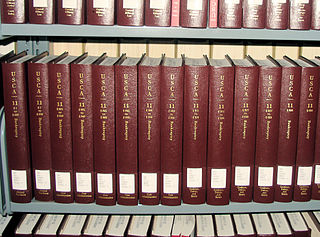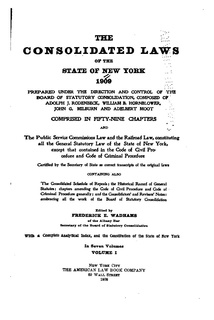
The Code of Laws of the United States of America is the official compilation and codification of the general and permanent federal statutes of the United States. It contains 53 titles. The main edition is published every six years by the Office of the Law Revision Counsel of the House of Representatives, and cumulative supplements are published annually. The official version of those laws not codified in the United States Code can be found in United States Statutes at Large.
Special districts are independent, special-purpose governmental units that exist separately from local governments such as county, municipal, and township governments, with substantial administrative and fiscal independence. They are formed to perform a single function or a set of related functions. The term special district governments as defined by the U.S. Census Bureau excludes school districts. In 2007, the U.S. had more than 37,000 special district governments.
The Constitution Act, 1982 is a part of the Constitution of Canada. The Act was introduced as part of Canada's process of patriating the constitution, introducing several amendments to the British North America Act, 1867, including re-naming it the Constitution Act, 1867.. In addition to patriating the Constitution, the Constitution Act, 1982 enacted the Canadian Charter of Rights and Freedoms; guaranteed rights of the Aboriginal peoples of Canada; provided for future constitutional conferences; and set out the procedures for amending the Constitution in the future.
The Florida Statutes are the codified, statutory laws of Florida; it currently has 48 titles. A chapter in the Florida Statutes represents all of the relevant statutory law on a particular subject. The statutes are the selected reproduction of the portions of each session law, which are published in the Laws of Florida, that have general applicability.

The Code of Virginia is the statutory law of the U.S. state of Virginia, and consists of the codified legislation of the Virginia General Assembly. The 1950 Code of Virginia is the revision currently in force. The previous official versions were the Codes of 1819, 1849, 1887, and 1919, though other compilations had been printed privately as early as 1733, and other editions have been issued that were not designated full revisions of the code.
Public-benefit corporations are a specific type of corporation that allow for public benefit to be a charter purpose in addition to the traditional corporate goal of maximizing profit for shareholders. Depending on the country they may also be known as crown corporations, statutory corporations, or government owned corporations having monopoly over a specific service or market..
To cities, counties, towns, townships, charter townships, villages, and boroughs. The term can also be used to describe municipally owned corporations.
The government of Texas operates under the Constitution of Texas and consists of a unitary democratic state government operating under a presidential system that uses the Dillon Rule, as well as governments at the county and municipal levels.
The California Codes are 29 legal codes enacted by the California State Legislature, which together form the general statutory law of California. The official Codes are maintained by the California Office of Legislative Counsel for the Legislature. The Legislative Counsel also publishes the official text of the Codes publicly at leginfo.legislature.ca.gov.
In the U.S. state of Vermont, villages are named communities located within the boundaries of an incorporated town. Villages may be incorporated or unincorporated.
The Annotated Code of Maryland, published by The Michie Company, is the official codification of the statutory laws of Maryland. It is organized into 36 named articles. The previous code, organized into numbered articles, has been repealed.

A "Little Miller Act" is a U.S. state statute, based upon the federal Miller Act, that requires prime contractors on state construction projects to post bonds guarantying the performance of their contractual duties and/or the payment of their subcontractors and material suppliers.

The Administrative Procedure Act (APA), Pub.L. 79–404, 60 Stat. 237, enacted June 11, 1946, is the United States federal statute that governs the way in which administrative agencies of the federal government of the United States may propose and establish regulations. To protect citizens, the APA also grants the judiciary oversight over all agency actions. It is one of the most important pieces of United States administrative law.
The copyright status of works produced by the governments of states, territories, and municipalities in the United States varies. Copyright law is federal in the United States. Federal law expressly denies U.S. copyright protection to two types of government works: works of the U.S. federal government itself, and all edicts of any government regardless of level or whether or not foreign. Other than addressing these "edicts of government", U.S. federal law does not address copyrights of U.S. state and local government.
The law of Illinois consists of several levels, including constitutional, statutory, and regulatory law, as well as case law and local law. The Illinois Compiled Statutes (ILCS) form the general statutory law.

The Consolidated Laws of the State of New York are the codification of the permanent laws of a general nature of New York enacted by the New York State Legislature.










